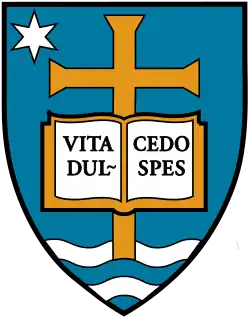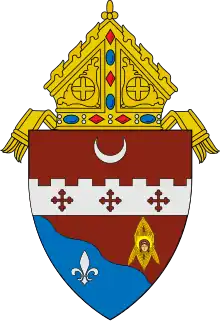Basilica of the Sacred Heart (Notre Dame)
The Basilica of the Sacred Heart in Notre Dame, Indiana, USA, is a Roman Catholic church on the campus of the University of Notre Dame, also serving as the mother church of the Congregation of Holy Cross (C.S.C.) in the United States. The neo-gothic church has 44 large stained glass windows and murals completed over a 17-year period by the Vatican painter Luigi Gregori. The basilica bell tower is 230 feet (70 m) high, making it the tallest University chapel in America.[5][6] It is a contributing building in Notre Dame's historic district listed on the National Register of Historic Places.[7] The Basilica is a major tourist attraction in Northern Indiana, and is visited annually by more than 50,000 tourists. [8]
| Basilica of the Sacred Heart | |
|---|---|
 Basilica looking northwest from the Main Quad | |
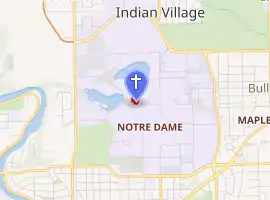
| |
| Location | University of Notre Dame Notre Dame, Indiana |
| Country | United States |
| Denomination | Catholic Church |
| History | |
| Status | University church Mother church of the Congregation of Holy Cross in the United States |
| Consecrated | 15 August 1888 |
| Architecture | |
| Functional status | Active |
| Architect(s) | Edward Sorin, Alexis Granger |
| Architectural type | Basilica |
| Style | Gothic Revival |
| Groundbreaking | 1870 |
| Specifications | |
| Capacity | 1,000 |
| Length | 275 feet (84 m) |
| Width | 114 feet (35 m) |
| Height | 230 feet (70 m) |
| Materials | Brick, limestone |
| Bells | 23 (1867)[1] |
| Tenor bell weight | 7 long tons 0 cwt (15,700 lb or 7.1 t) |
| Administration | |
| Diocese | Fort Wayne–South Bend |
| Clergy | |
| Rector | Rev. Brian C. Ching, C.S.C.[2][3] |
Basilica of the Sacred Heart | |
 | |
| Location | Notre Dame, Indiana |
| Coordinates | 41°42′09″N 86°14′23″W |
| Built | 1871-1888[4] |
| Architect | Father Alexis Granger, Father Edward Sorin and Brother Charles Harding [4] |
| Architectural style | Gothic Revival |
| Part of | University of Notre Dame: Main and North Quadrangles (ID78000053) |
| Added to NRHP | 23 May 1978 |
History
In 1686, Fr. Claude-Jean Allouez, S.J., established the Ste-Marie-des-Lacs mission on the south shore of the St. Mary's lake, in order to serve the local Potawatomi tribe along with French trappers and settlers in the area. The French Catholic missionaries were expelled by the British from the area following the French and Indian War in 1763, but in 1832 Ste-Marie-des-Lacs was re-established by Stephen Badin and the Log Chapel (University of Notre Dame) was built.
The first church
When Rev. Edward Sorin, C.S.C., established the University of Notre Dame, the community held religious services in the small log cabin built by Stephen Badin. This was replaced by a larger log cabin between 1842 and 1843.
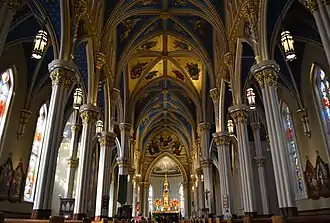
The growth of the institution required a proper church, and school leaders decided to spend $1500 to construct a new edifice. Work began on 25 May 1848, and the structure was dedicated on 12 November of the following year. The solemn consecration took place a year later, on 11 November 1849, with Bishop of Vincennes, Maurice de St. Palais presiding.[9] Father Sorin describes the first church: "The style is Greek, with rounded arches. There are three vaults and six columns which produce a very pretty effect. The tribune, which has been built for the use of the Sisters, is elliptical like the sanctuary. It is already enriched with an organ of Mr. H. Erben, and, though a little weak for the church, is one of its most precious ornaments."[10]
Shortly after the completion of the church, the university added a bell to its tower. In the spring of 1851, the wind swept tower and bell to the ground. That summer, university leaders purchased a larger bell in Cincinnati weighing 3,220 pounds (1,460 kg) and installed it in one of the church towers after it was blessed on the feast of the Assumption. In 1852 double spires were built by a local carpenter in exchange for his son's tuition at the school.[11]
The second (and present) church
The University's needs soon outgrew the small first church and in spring of 1869 the leaders decided to build a new church dedicated to Our Lady of the Sacred Heart, despite the lack of funds in the school's treasury.
_-_interior%252C_vault.jpg.webp)
Popular architect Patrick Keely drew the first plans which envisioned a baroque plan similar to the Church of the Gesu in Rome.[12] Because of the limited budget, the church at Notre Dame was not to be as large or as elaborate as the Roman edifice, but rather the size of the church of the same name in Montreal.[13] The original plan featured a cruciform church two hundred feet in length with three naves and a transept, a dome over the crossing, two large bell-towers, and a capacity of 2,000. The estimated cost would be around $100,000.
Fr. Sorin decided that these plans were too grandiose, and that the church could not cost more than half that sum, since at the moment they had only about $8,000 dollars at hand. In January 1870, a new architect, Mr. T. Brady from St. Louis, drew new plans for the church. It is not sure who drew the definite plans, but it is likely that also Fr. Sorin, Rev. Alexis Granger, C.S.C., and Irish-born Brother Charles Borromeo Harding, C.S.C., a hard-working, self-taught campus builder were part of the planning and building. The new church was erected in Gothic style rather than baroque, reflecting Fr. Sorin's French taste and his will to build a remarkable and striking landmark. Work on the foundations for the new church began in the spring of 1870, and the cornerstone was laid on 31 May 1871, with six bishops present, including Cincinnati Archbishop John Purcell. The building took many years to finish and underwent many changes. As soon as it was inhabitable, university leaders installed an organ and held functions and celebrations in the unfinished building. Bishop Joseph Gregory Dwenger finally consecrated the new sanctuary on 15 August 1888. In 1931, it underwent its first thorough renovation by designed by New York architect Wilfred E. Anthony.
_-_interior%252C_The_Lady_Chapel%252C_mural%252C_The_Exaltation_of_the_Holy_Cross_by_Luigi_Gregori%252C_looking_straight_up.jpg.webp)
In 1968, the church was renovated with the intention of bringing it in line with the liturgical reform of the Second Vatican Council. The church again received a renovation 20 years later, executed by Conrad Schmitt Studios, during which some of the 1968 renovations were reverted.[14] The conservation and restoration of the historic stained glass windows, created in Le Mans, France, was one of the studio's largest single projects, with 116 windows and over 1,200 panels of glass. On 17 January 1992, Pope John Paul II raised the Church of the Sacred Heart to the status of Minor basilica. This designation is one factor in making it a popular destination for approximately 50,000 pilgrims and tourists who visit annually. From 1977 through 1997, Rev. Daniel R. Jenky, C.S.C., of the Diocese of Peoria, Illinois, served as rector of the basilica, before he became head of the religious community there and later Auxiliary Bishop and vicar general of The Dioceseof Fort Wayne–South Bend and later Bishop of the Diocese of Peoria, Illinois. Under his tenure, the church was elevated to a basilica.[15]
The Basilica was the site of the funeral of many members of the community, including that of Theodore Hesburgh and Regis Philbin.[16]
Exterior
The exterior of the church is constructed of Notre Dame brick and features a bell tower with a spire and two lateral pinnacles. The bell tower is 218 feet tall, and topped by a 12 feet tall golden cross, making its total of 230 feet the tallest height on campus.[17]
_-_exterior%252C_east_portal%252C_memorial_to_Notre_Dame_students_killed_in_WWI.jpg.webp)
World War I Memorial Door
Plans for a memorial for Notre Dame's contributions to World War I began in 1919 shortly after the Armistice. Funds were collected by the Notre Dame Service Club and the local chapter of the Veterans of Foreign Wars. Notre Dame architects Francis Kervick and Vincent Fagan designed the work for a memorial door on the east transept of the basilica. The final design featured a door surmounted by a pointed arch and flanked by two buttresses, all in gothic style and yellow brick as the rest of the Basilica. Initially, the memorial was meant to commemorate all 2,500 Notre Dame affiliates who fought in the war, including future presidents Rev. Matthew J. Walsh and Rev. Charles L. O'Donnell who had served as military chaplains. However, later revisions to the plan reduced it to two plaques flanking the door and commemorating the 46 Notre Dame students, alumni, and faculty who died in combat. The door itself is in oak with iron hinges, and contains two stained glass windows displaying the Tudor Rose and the Poppy. The stone lintel topping the door is inscribed with the words “In Glory Everlasting”, while above the lintel a carved panel depicts two eagles supporting a shield with the old university seal (in use before 1930) and carrying in their claws a ribbon which the words “God, Country, Notre Dame.” Above the door, the words "Our Gallant Dead" are inscribed in the stone facade. [18] Statues of Jean of Arc and St. Michael by Rev. John J. Bednar, CSC, were added to the niches in the buttresses above the door in 1944, during the a campus beautification project.[19] President Rev. Matthew J. Walsh dedicated the World War I Memorial Door on Memorial Day 30 May 1924 with a military mass. [20]
Interior
Altars
The basilica has three altars. The first is a high altar in Gothic Revival style, a graceful object in bronze built in shops of Froc-Robert in Paris for the Centennial Exposition in Philadelphia, during which it won a design award.[21] After the Exposition, Father Sorin purchased the piece for the church. The tabernacle tower, which holds the reserved Blessed Sacrament, was inspired by Revelation 21:9, the vision of the new Jerusalem. Following the Second Vatican Council the gothic altar was moved to the apse, and a new altar was placed in the transept. This altar, called the Altar of Sacrifice, was made from old pews and choir stalls from the Lady Chapel. The third altar is a baroque altar in the Lady Chapel believed to come from the studios of Giovanni Bernini in Rome. Next to the gothic altar there are the Umbraculum and the Tintinnabulum, which are adorned with the insignia of the Roman Pontiff and the coat of arms of the Basilica, the diocesis, and the congregation. These two objects are symbols of the designation of minor basilica. The baptismal font, which is located at the entrance of the church, dates from 1871.[22]
Frescoes
The frescoes adorning the walls and the ceilings of the nave were painted by Vatican painter and artist in residence Luigi Gregori.[23] The ceilings are filled with a starry sky with angels, while the walls and transept are decorated with figures of saints. Each of the 12 bays of the vaulted veilinceuling is decorated with an angel, for a total of 96 painted angels. Gregori also painted the stations of the Cross that decorate the walls of the main nave. The neogothic style of the frescoes is similar to that of Santa Maria sopra Minerva, which was done by Bernardino Riccardi, Pietro Gagliardi, Tommaso Greggia, and Raffaele Casnédi in the mid 1800s. This style was inspired by Italian gothic decorations, such as the Basilica of Saint Francis of Assisi or the Scrovegni Chapel.
The saints depicted on the left side of the nave: Apollonia, Anthony, Bernard of Clairvaux, Dominic, Francis, Stanislaus Kostka, Aloysius Gonzaga, Rose of Lima, Agnes. On the right side of the nave: John the Baptist, John the Evangelist, Mary Magdalene, St Alexius, Benedict Joseph Labre, Thomas Aquinas, St. Jerome, St. Lucy, St. Cecilia. On the left side of the choir the paintings of the Sacred Heart of Jesus, Gregory the Great, Ignatius of Loyola and on the right side of the choir: Immaculate Heart of Mary, Augustine of Hippo, Benedict of Nursia.[24]
At the crossing, the ceiling is gold instead of blue, marking the sanctuary of the church, and is adorned with the figures of the four evangelists and Old testament prophets: Isaiah holding a scroll, David with a harp, Jeremiah with a scroll, and Moses with the tablet of the law, plus the evangelists Matthew (angel), John (eagle), Luke (ox), and Mark (lion) from the New Testament. The frescoes in the transept episodes of the life of Mary, such as the Nativity of Mary, Presentation of Mary, the Annunciation, Marriage of the Virgin, the Visitation, Nativity of Jesus, Mary Queen of Heaven.[25] The fresco at the entrance of the Lady Chapel depicts the Coronation of the Virgin Mary as Queen of Heaven and was devised in 1874 and painted in 1887. Mary is crowned with a tiara of roses by Christ and God the Father under a dove symbolizing the Holy Spirit; the group is surrounded by figures from the Old and New Testaments holding scrolls and quills.[26]
_-_interior%252C_stained_glass%252C_Dormition_of_the_Blessed_Virgin_Mary.jpg.webp)
At the end of apse, on the left wall, there is a mural depicting apparition of Our Lady of Lourdes to St. Bernadette in 1858 and on the right one a mural depicting the death of St. Joseph.[27] In the Lady Chapel, Gregori painted the luminous exaltation of the Cross, where the True Cross is exalted under the motto, Spes Unica. At the center of the fresco is the cross, supported by angels. A holy host carrying the instruments of Christ's passion surrounds the cross. Saints and prophets are arranged all around: St. Patrick is depicted behind St. Mark, holding a clover, and was added by Gregori after requests from the student body to honor its Irish heritage. In the foreground there are the figures of Saint Helena, the mother of the Roman Emperor Constantine, and Saint Macarius, the bishop of Jerusalem, who are said to have found the Cross in 325 AD.
_-_interior%252C_vault_at_the_crossing%252C_four_Old_Testament_prophets_and_the_four_evangelists.jpg.webp)
Windows
The 116 stained glass windows consist of more than 1,200 individual panels and were designed and made by the Carmelite nuns in Le Mans, France and painted by Eugène Hucher and associates. The 44 large windows depict 114 life-size scenes and 106 smaller scenes. [28] They were installed beginning in 1873, over a period of 15 years. The subjects of the windows were carefully chosen by Fr. Sorin with a pedagogic purpose, and the choice and positioning of the depicted figures is intentional and highly symbolic. [29]
The windows depict saints, apostles, theologians, and biblical scenes and many of the figures are life-sized. Each of the 16 windows in the nave and transepts depicts 4 saints for a total of 64 figures, and each window has a theme (for example 4 saints who were kings or 4 who were nuns). The fourth windows of the nave represent the Great Fathers: the window on the east side of the nave depicts the Eastern Church fathers: Basil of Caesarea, Gregory Nazianzus, Athanasius of Alexandria, John Chrysostom; the window on the west side represent the Western Church fathers: Augustine, Saint Jerome, Ambrose, Gregory the Great.[30]
The window on the north side of the west transept depicts the Sacred Heart of Jesus that inspired the Basilica's name, while another on the south side shows Father Sorin presenting the building to God.[31] The windows in the Lady Chapel depict stories for Christ's Life and each side chapel has its own theme that is depicted in its windows. The East and West transepts feature two large windows: the eastern window depicts the Pentecost, and its positioned towards the rising sun to symbolize rebirth, while the western transept depict the Dormition of Mary, and it is positioned towards the setting sun to symbolize the end of earthly life.[32]
Side chapels
The Basilica contains seven side chapels. From left to right:
_-_interior%252C_The_Lady_Chapel%252C_baroque_altar_built_by_Bernini's_studio.jpg.webp)

- The Chapel of the Holy Cross with the Stations of the Cross contains the tomb of John Francis O’Hara, C.S.C., university president from 1934 to 1940 and the first member of the Congregation of Holy Cross named a cardinal. The chapel also holds the Return of the Prodigal Son statue by Ivan Mestrovic. The windows depict the Passion of Christ.[33]
- The Chapel of Our Lady of Victory contains a statue of Blessed Basil Moreau, C.S.C., founder of the Congregation of Holy Cross and beatified on September 15, 2007. The statue was sculpted by Robert Graham and contains a relic of Blessed Basil Moreau. It also hosts a copy of the 'New Icon of the Martyrs and Witnesses to Faith of the Twentieth Century', kept at San Bartolomeo all'Isola. The windows in the chapel depict stories connected to Mary in history: two panels depict the Battle of Lepanto, then Louis IX promises a pilgrimage to Nazareth, then Louis XIII and Cardinal Richelieu increased devotion to Our Lady of Victories, then Our Lady of Victories with the Child Jesus above the globe of universe, and John Eudes venerating the Immaculate Heart of Mary[34]
- The Chapel of Holy Angels contains a framed modern painting of Our Lady of Guadalupe, painted by Maria Tomasula, Professor of Art and Art History and The Michael P. Grace II Chair in Arts and Letters, University of Notre Dame in 2008. The stained glass windows depict famous angels from the Bible, such as Michael defeating Satan, Raphael and Tobit, the angel liberating St. Peter, Gabriel appearing to Mary, Gabriel appearing to Zechariah.[35]
- The center chapel, behind the altar, is the largest and most prominent and is the Lady chapel. The Lady Chapel was a common feature in medieval cathedrals and it was also inspired by the one present in St. Patrick's Cathedral in New York. The main feature of the chapel is the statue of Mary. Under it, is a baroque altar believed to come from the studios of Giovanni Bernini in Rome, where Fr. Sorin saw it during one of his trips. The tabernacle doors contain a fragment of wood believed to be from a table on which St. Peter celebrated Mass in Rome. The Chapel, also known as Chapel of the Exaltation of the Holy Cross (depicted in the ceiling painted by Luigi Gregori) and Sacred Heart Chapel, was added on to the Basilica in 1886 to help celebrate the 50th anniversary of Fr. Sorin's ordination in 1888. The windows depict stories from the life of Jesus.
- The Reliquary Chapel houses relics of the Twelve Apostles, a piece of the True Cross, the burial of St. Severa, and numerous other objects of veneration. The wax figure is of St. Severa, a third century martyr. The cloth covered boxes at her head and feet contain her relics. Above the relic case is a copy of a portion of Raphael's fresco, Disputation of the Holy Sacrament. The chapel also hosts a copy of the Bronze statue of Saint Peter in Saint Peter's Basilica and a copy of the icon of Our Lady of Czestochova. The windows depict stories and miracles of Christian relics, such as the Translation of the Relics of Saint Nicholas from Myra to Bari or the relics of St. Martin.
- The Brother Andre Chapel, which houses a statue of Saint Andre Bessette, C.S.C., is dedicated to the first saint of the Congregation. He was canonized in 2010 for his work among the needy in Montreal. The chapel holds a statue of Saint André Bessette was designed by the Rev. Anthony Lauck, C.S.C. (1985). The windows depict episodes about Mary starting with the presentation to the temple.
- The Holy Family Chapel honors the life of St. Joseph and hosts Ivan Mestrovic's masterpiece, The Descent from the Cross or Pieta. The sculptor did the sketches for this magnificent pieta while he was a political prisoner of the Nazis. Mestrovic used his own likeness for Joseph of Arimathea. The work was exhibited at New York's Metropolitan Museum of Art before going on display in the church in 1955. A copy of it is held at the Vatican Museums. The windows of the Chapel depict stories of the Holy Family and the Nativity.
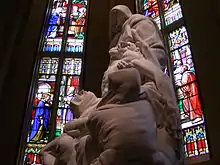
Organ

The first Sacred Heart Church had a small reed organ in the 1850s. In 1865 Father Edward Sorin approved its replacement with a hand-pumped organ of 1,500 pipes. In 1875 Derrick and Felgemeker of Erie installed a 2,000 pipe organ inside the new and still incomplete Sacred Heart Church, which was eventually brought inside the completed church. In 1961 university president Rev. Theodore M. Hesburgh approved the addition 300 pipes to the organ. On April 2, 1978, a new organ is installed, donated by Marjorie O'Malley and built by the Holtkamp Organ Company of Cleveland, Ohio. It debuted at a dedication Mass celebrated by Hesburgh and a recital performed by Professor Michael Schneider of Cologne, Germany. Professor Craig Cramer joined Notre Dame's Department of Music in the fall of 1981 and inherited department chair Calvin Bower's charge to form the organ performance program.[36]
In late 2006, Campus Ministry formed a committee to consider replacement of the basilica organ, headed by Dr. Gail Walton, the basilica's director of music since 1988. The committee performed a nationwide search, and in December 2006 it traveled to Columbus, Ohio, for the dedication of the new Paul Fritts organ in Saint Joseph Cathedral and decided to commission the new organ to Fritts, which became Fritt's second commission from Notre Dame. Previously, Paul Fritts and Company Organ Builders of Tacoma, Washington, had finished a 35-stop organ, also an O’Malley gift, designed in the northern German tradition, for the Reyes Organ and Choral Hall of the new DeBartolo Performing Arts Center in 2004. The Great Recession of 2008 halted the project by taking a hit on the university endowment and benefactions, and the idea of replacing the basilica organ was tabled indefinitely. The project was further dealt a blow by the death of its foremost champion Gail Walton in February 2010. Yet, in the fall of 2010, the university approves a plan to commission a new organ for the basilica and the begins to search for a donor. As decided previously, organ maker Paul Fritts was commissioned with the project and began to design and authorizes pipe making in 2012 before signing the contract. Work on the case in Tacoma began in 2013. The project eventually called for a four-manual instrument with 70 stops, 5,164 pipes and a case inspired by Dutch masterpieces, and it was to become Fritts’ magnum opus. The basilica closed in Christmas 2013 for the first phase of the organ project, the a 44-day replacement of the church carpeting with 25,000 slate-colored porcelain tiles to improve acoustics. In the meanwhile, a third Fritts commission, sponsored by Denis ’67 and Susan McCusker, sees a studio organ designed in 2014 for the Walton Choir Rehearsal Hall in Coleman-Morse Center. On December 28, 2015, the Holtkamp organs played its last song, Silent Night, before its dismantling started the next morning. The organ pipes were donated to the reconstruction of a local parish, Pius XI in Granger Indiana. In October 2015, Fritts loans the church the fourth organ once the Holtkamp is removed. Work commences on reinforcing the choir loft’s concrete and adding steel support structures to the foundation. During the installation of the new organ, the basilica choirs will sing next to the interim organ in the west transept. [37]
The new organ, named for benefactors Wayne and Diana Murdy, was transported onto a pair of tractor-trailers to the basilica on Sunday, July 31 2016. By end of August 2016, the façade and case was completed, and Fritts Company beginned the process of tuning and voicing the pipes and connecting the organ's key action, stop actiwind worksorks and electrical wiring. The organ's first full performance test occurred during the annual Blue Mass honoring police, firefighters and emergency medical personnel on October 6, with the tuning of last rank of pipes in the following weeks. It was finished on schedule for Christmas 2016. [38] The new four-manual 70-stop Murdy Family Organ was designed and built by Paul Fritts & Company Organ Builders as its Opus 37. It has 4 keyboards, 70 stops and 5,164 pipes and stands 40 feet high and weighs more than 20 tons. Before installation, workers had to reinforce the loft to support the larger instrument.[39][40] Bishop Daniel Jenky returned to campus to dedicate the instrument on 20 January 2017 which featured a recital by University professor and organist Craig Cramer.[41]
Basilica museums
The Basilica's museum, located behind the sacristy, displays artifacts from the history of the University and the Congregation of Holy Cross. Many items belonged to Fr. Edward Sorin, founder of the University. Items on display also include liturgical vessels and chalices, personal effects of Luigi Gregori, a cassock that belonged to Pope Paul VI, chalices and cassock of Pope Pius IX, and a six-foot- high processional cross presented to Notre Dame by Napoleon III and Empress Eugenie. Of particular significance, a papal tiara from the 1850s donated to Edward Sorin by Pope Pius IX. It is only one of two in existence outside the Vatican, and of these two the only traditional one, the other being the modernist tiara of Paul VI.
The basement holds the Bishop's Museum, which contains pontificalia of various American bishops, dating from the 19th century. It hosts ornate and embroidered vestments, mitres, shoes, caps, sandals, sashes, gloves, Cardinals’ galeros, chalices, vestments embroidered by the daughter of the Empress of Austria. These include Rev. Alexis Granger's sick-call satchel, containing oils to anoint the sick; crosier and pectoral cross of the Reverend John Carroll (first Catholic bishop of the United States); a gold screen from the sanctuary of Santa Brigida through which St. Bridget of Sweden used to hear Mass; mitre of bishop Michael Francis Egan (first bishop of Philadelphia); crosier, mitre, and rabbi used by cardinal John McCloskey, first bishop of Albany; maniple from 1840 of the first bishop of California, Francisco Diego; cassock and books written by and about Archbishop Marcos G. McGrath, CSC.
Liturgies

The basilica is the main liturgical center for the university community. Mass is held twice daily, while the university is in session, and once daily during breaks. Each weekend there are three Sunday masses celebrated for students, faculty, staff and community members. The basilica is a popular place for weddings of Notre Dame alumni, hosting several weddings each Saturday, whenever the Fighting Irish do not have a home football game. The basilica has also been the site of final professions and ordination masses for the Congregation of Holy Cross, as well as funerals for the religious community and for alumni.
_-_interior%252C_original_altar_(designed_by_Froc-Robert_and_Sons_of_Paris)_with_tabernacle_tower.jpg.webp)
Each Sunday evening the basilica holds Solemn Vespers and a special service during Advent, known as Lessons and Carols. Stations of the Cross is celebrated each Friday during the season of Lent. At other times throughout the year, the basilica hosts special liturgies of all kinds. The Paschal Triduum is celebrated every Easter and it lasts from Holy Thursday with the celebration of the Last Supper until Easter Sunday with Vespers. These celebrations are very popular among students and local inhabitants, and Easter liturgies are always very crowded. Located in the Crypt Church (basement level) of the basilica is Sacred Heart Parish. Two people are buried in the Basilica: Cardinal John Francis O'Hara, who is buried in the Chapel of the Holy Cross, and Orestes Brownson, who is buried in the crypt.
Broadcasts
Since 2002, Sunday masses from the basilica have been broadcast nationwide. Special care is taken to ensure that broadcasting equipment captures the beauty of the mass without impacting the rite. Currently, the 10:00 A.M. mass is broadcast on CatholicTV, while the 11:45 A.M. mass is broadcast online at NDPrayerCast.org and through iTunes.
Carillon
The original 23 bells were installed in 1856 and make-up the oldest carillon in North America. They were made in France, and each has a name related to Mary. The final bell, which is one of the grandest in the United States, was blessed in 1888, during Father Sorin's Golden jubilee. It is named for St. Anthony of Padua, it is an immense bass bell, or bourdon, more than seven feet tall and weighing 15,400 pounds.
Gallery
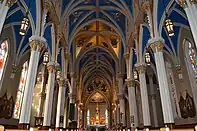 Nave
Nave Basilica in the winter
Basilica in the winter Basilica in the summer
Basilica in the summer_-_exterior.jpg.webp) East façade
East façade_-_exterior%252C_front_portal.jpg.webp) Main portal
Main portal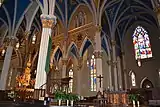 Pulpit and altar
Pulpit and altar
References
- "Tower Bells: Notre Dame: USA–IN". TowerBells.org. Retrieved 9 February 2016.
- https://holycross.nd.edu/news/father-peter-rocca-c-s-c-retires-as-rector-of-basilica/
- https://holycross.nd.edu/directory/rev-brian-c-ching-c-s-c/
- "Official Building Inventory" (PDF). Facilities Design and Operations. University of Notre Dame. 1 October 2015. Archived from the original (PDF) on 4 March 2016. Retrieved 11 November 2015.
- GmbH, Emporis. "Basilica of the Sacred Heart, Notre Dame | 127384 | EMPORIS". www.emporis.com.
- "God and Obama at Notre Dame".
- James T. Burtchaell (November 1976). "National Register of Historic Places Inventory/Nomination: University of Notre Dame Campus-Main and South Quadrangles" (PDF). Indiana State Historic Architectural and Archaeological Research Database and National Park Service. Retrieved 18 October 2017. With seven photos from 1972-76. Map of district included with version available at National Park Service.
- "Basilica of the Sacred Heart is the heart of Indiana's University of Notre Dame campus". Midwest Guest.
- Hope, C.S.C., Arthur J. (1999). "Notre Dame — One Hundred Years: Chapter V". University of Notre Dame.
- 16 Sorin, Chronicle, 84-85.
- "Basilica of the Sacred Heart is the heart of Indiana's University of Notre Dame campus". Midwest Guest. Retrieved 15 January 2019.
- St. Joseph Valley Register, 30 September 1869.
- Lemonnier to Edwards, 7 July 1869. Lemonnier Letters. UNDA.
- "Basilica of the Sacred Heart is the heart of Indiana's University of Notre Dame campus". Midwest Guest. Retrieved 15 January 2019.
- "The Most Reverend Daniel R. Jenky C.S.C: Biography". Diocese of Peoria. Retrieved 30 October 2017.
- Report, Staff. "Regis Philbin funeral service, burial to be held on Notre Dame campus". The Indianapolis Star. Retrieved 29 July 2020.
- "10 Iconic Landmarks at Notre Dame". Visit South Bend Mishawaka. 28 October 2018. Retrieved 15 January 2019.
- Scholastic (PDF). 57 (9): 232–233. May 1924 http://archives.nd.edu/Scholastic/VOL_0057/VOL_0057_ISSUE_0009.pdf. Retrieved 7 November 2019. Missing or empty
|title=(help) - "World War I Memorial Door". Notre Dame Archives. 30 May 2016.
- "World War I Memorial Door". Notre Dame Archives. 30 May 2016.
- "Basilica of the Sacred Heart is the heart of Indiana's University of Notre Dame campus". Midwest Guest. Retrieved 15 January 2019.
- "Basilica of the Sacred Heart is the heart of Indiana's University of Notre Dame campus". Midwest Guest. Retrieved 15 January 2019.
- "Artist in Residence: Working Drawings by Luigi Gregori (1819–1896)" (PDF). The Snite Museum of Art. Retrieved 6 December 2018.
- O'Meara, Thomas (1991). The Basilica of the Sacred Heart at Notre Dame : a theological guide to the paintings and windows (1st ed.). Notre Dame, IN: Ave Maria Press.
- O'Meara, Thomas (1991). The Basilica of the Sacred Heart at Notre Dame : a theological guide to the paintings and windows (1st ed.). Notre Dame, IN: Ave Maria Press.
- sniteartmuseum.nd.edu (PDF) https://sniteartmuseum.nd.edu/assets/68585/gregori_artist_in_residence_catalog_2.5_mb_pdf_.pdf. Retrieved 12 January 2019. Missing or empty
|title=(help) - campusministry.nd.edu (PDF) https://campusministry.nd.edu/assets/279049/basilicatourguide_final.pdf. Missing or empty
|title=(help) - Report, South Bend Tribune. "Stained glass windows in Notre Dame's basilica topic of talk". South Bend Tribune.
- "Professor explains history, significance of Basilica stained glass // The Observer". The Observer. 15 October 2014.
- O'Meara, Thomas (1991). The Basilica of the Sacred Heart at Notre Dame : a theological guide to the paintings and windows (1st ed.). Notre Dame, IN: Ave Maria Press.
- "Version 3.2". www.irishlegends.com.
- "Professor explains history, significance of Basilica stained glass // The Observer". The Observer. 15 October 2014.
- O'Meara, Thomas (1991). The Basilica of the Sacred Heart at Notre Dame : a theological guide to the paintings and windows (1st ed.). Notre Dame, IN: Ave Maria Press.
- O'Meara, Thomas (1991). The Basilica of the Sacred Heart at Notre Dame : a theological guide to the paintings and windows (1st ed.). Notre Dame, IN: Ave Maria Press.
- O'Meara, Thomas (1991). The Basilica of the Sacred Heart at Notre Dame : a theological guide to the paintings and windows (1st ed.). Notre Dame, IN: Ave Maria Press.
- "The Timeline of the Basilica Organ Project // Notre Dame Magazine // University of Notre Dame". magazine.nd.edu. Retrieved 26 March 2019.
- "The Timeline of the Basilica Organ Project // Notre Dame Magazine // University of Notre Dame". magazine.nd.edu. Retrieved 26 March 2019.
- "The Timeline of the Basilica Organ Project // Notre Dame Magazine // University of Notre Dame". magazine.nd.edu. Retrieved 26 March 2019.
- Nagy, John (Autumn 2015). "Magnum Opus". Notre Dame Magazine. Retrieved 9 February 2016.
- Morgan, Kate (7 December 2015). "Basilica of the Sacred Heart to close for next phase of organ installation". Notre Dame News. Retrieved 9 February 2016.
- Becker, Courtney (20 January 2017). "Bishop to dedicate the Murdy Family Organ in the Basilica of the Sacred Heart". The Observer.
External links
| Wikimedia Commons has media related to Basilica of the Sacred Heart, University of Notre Dame. |
